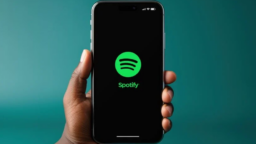The dispute between US music publishers and Spotify has been one of the more dramatic music business stories of the year.
Yet despite the sometimes harsh words that publishers have had for Spotify over its decision to classify its Premium music subscription tier as a “bundle” with audiobooks – thereby reducing mechanical royalty payouts to song owners – Spotify has made it clear that it doesn’t plan to back down.
“Many platforms take bundled treatments, so we’re not unique in that regard,” Ben Kung, Spotify’s VP of Financial Planning and Analysis and interim CFO, said on the company’s latest earnings call on Tuesday (July 23).
“We won’t be commenting on the specifics of the mechanics of our deals, but all we can say is that we’re very confident in our position [and] in the path that we’re on at this point.”
For his part, co-founder and CEO Daniel Ek suggested that, even with the reduced mechanical royalty payouts, Spotify will be paying out more to rights holders this year, and going forward.
“I think a lot of people want to make this sort of a zero-sum game, where we have to win in order for them to lose, or they have to win, and then we sort of lose. It is not fundamentally how we view this at all. We look at it [as] much more of a win-win,” Ek said.
“Overall, whether on the publishing side or the label side, when I look at our numbers, we keep increasing our payouts year over year… Last year, on the publishing side, we had record payouts in 2023. This year, 2024, we will beat those numbers and have even more payouts [to publishers]. And the same will, of course, be true on the label side. So it is not as much of a zero-sum game as people make it [out to be].”
“I think a lot of people want to make this sort of a zero-sum game, where we have to win in order for them to lose, or they have to win, and then we sort of lose. It is not fundamentally how we view this at all.”
Daniel Ek, Spotify
The dispute began this spring, when Spotify notified publishers that it had decided to classify its Premium subscription plans in the US as bundles, given that, since last November, they included 15 hours of audiobooks.
Under the US Copyright Royalty Board’s ‘Phonorecords IV’ rules, streaming services can pay out lower royalty rates from bundled streaming subscriptions than from standalone music subscriptions.
That move drew a harsh response from the National Music Publishers’ Association (NMPA), which accused the Sweden-headquartered streaming service of “attacking the very songwriters who make its business possible,” in the words of NMPA President and CEO David Israelite.
Spotify’s move also triggered a lawsuit by The Mechanical Licensing Collective (MLC), the body created to collect mechanical royalties under the US’s Music Modernization Act (MMA).
The MLC, which says Spotify’s actions have resulted in an “almost 50% reduction” in the service provider revenue Spotify reports to The MLC from Spotify’s Premium individual, Duo and Family plans as a result of bundling, argued that Spotify’s Premium plans don’t qualify as actual bundles because the addition of audiobooks didn’t add anything more than “token value” to the subscription plans.
On the earnings call Tuesday, Spotify’s Ek argued that, despite there being “things that we’re arguing about,” the company has largely had a healthy relationship with the music business – and it’s in Spotify’s interest to see the industry grow stronger.
“We are spending a lot of time and effort in making sure that it keeps growing,” Ek said. “That is our primary thing that we’re doing as a company, and something we deeply care about as the core mission of this company, and I think that is recognized across the entirety of the music industry as well.”
Spotify on Tuesday reported its second straight quarter of profitability, the result of a pivot by the company from focusing on building a user base to improving margins, in what Ek calls a “year of monetization” for the company.
Spotify reported a record high operating income of EUR €266 million (USD $286.4 million) for Q2 of 2024, and its gross margin ballooned to 29.2%, from 24.1% in the same quarter a year earlier.
The number of paying subscribers grew to 246 million, up 12% YoY and an increase of 7 million paying subscribers from the previous quarter, beating guidance by 1 million.
If there was one area of weakness, it was SPOT’s Monthly Active Users (MAU) count, which came in at 626 million. While that was up 14% YoY, it missed guidance by 5 million.
The MAU count is effectively the sum total of paying subscribers and free (ad-supported) subscribers, so a quarter with strong paid subscriber growth and underwhelming MAU growth suggests weakness in the ad-supported side of the business. That has led some observers to wonder whether this means that Spotify’s subscriber funnel is hitting a wall.
Certainly, Spotify doesn’t think so. In its guidance for Q3, it’s forecasting an acceleration in MAU growth, with a net increase of 13 million, to a total of 639 million. It’s also predicting a 5 million jump in paid subs, to 251 million, and growth in its gross margin to 30.2%, on an operating income of €405 million.
Here are four other things we learned on Spotify’s latest earnings call:
1) Spotify has seen surprisingly little churn from its price increases
One way in which Spotify’s pivot from customer acquisition to profitability can be seen is in the sudden change to its approach to pricing. After years and years of no price hikes, Spotify raised monthly subscription rates in the summer of 2023 – and less than a year later, it raised them again in certain key markets, including the US and UK.
Naturally, analysts on the earnings call were curious to know whether those price hikes have resulted in churn, the polite business term for customers cancelling their subscriptions.
Per Spotify’s leadership, apparently it hasn’t – in fact, churn has been lower than they’d expected.
“We’re very encouraged by what we’re seeing in the three major markets where we’ve [hiked prices] two times in the last 12 months,” Kung said on the call, evidently referring to the US, UK, and Australia.
“We see that as a great data point for sort of what might be possible… in the rest of our territories,” he added.
But he cautioned not to take that hint of price hikes in other markets too much to heart, as it’s still “early days” in terms of the impact of a second price hike.
“We’ve only just taken this action, but we’re encouraged by… the cancellation rates basically being better than expected.”
“We’re very encouraged by what we’re seeing in the three major markets where we’ve [hiked prices] two times in the last 12 months.”
Ben Kung, Spotify
Kung also suggested that Spotify’s recent launch of a new “basic” tier helped mitigate churn from the price hikes, by offering customers the option of avoiding the price hike – assuming, of course, they’re happy with a music-only subscription.
Recent research suggests that Spotify’s churn rate has actually dropped dramatically in recent years, from 3.9% in 2021 to 2% in 2023, evidence that the streaming service’s expansion from music into podcasts and audiobooks has helped with customer retention.
And Spotify’s stratification of its subscription plans is part of what helped the company reach profitability in recent quarters, Ek said on the call.
“By introducing new subscription plans, we are successfully giving subscribers even more listening choices with options like the Audiobooks Access and basic tiers, that also builds on our already robust list of Premium plans around the world, including Individual, Duo, Student, Family and Mini passes,” Ek said.
2) The disappointing monthly active user numbers are the result of volatility in emerging markets
Daniel Ek offered an interesting explanation for why the growth in total active users hasn’t lives up to expectations: The Spotify CEO says it has to do with volatility in developing markets.
“Our paid subscription business is primarily anchored in developed markets where growth today is driven by net subscriber additions and strategic pricing,” Ek explained.
“On the other hand, the growth of our free ad-supported segment is focused today on developing markets, where we see potential to convert these users into subscribers, but on a much longer time horizon.”
He added: “We have significant potential to attract a large number of new users in developing markets. However, these users can be a little bit more inconsistent. Engagement looks different in these markets, as do the channels to acquire them, and conversion to paid can be a bit slower. This makes it difficult to get the same level of ROI effectiveness from our marketing spend [compared to developed markets].”
“We have significant potential to attract a large number of new users in developing markets. However, these users can be a little bit more inconsistent. Engagement looks different in these markets, as do the channels to acquire them, and conversion to paid can be a bit slower.”
Daniel Ek, Spotify
Ek also suggests that lower MAU growth may not have the same negative impact on subscriber growth as it might have had in the past.
“Historically, our conversion funnel was quite straightforward: a listener would come in as a free user, and over time, convert to our standard Premium tier. This process has evolved given the bifurcation between developed and developing markets and the increased number of subscription offers we now offer,” he said.
“This means the relationship from free to paid is no longer a one-size-fits-all scenario, and we’re less dependent on new free users to fuel our revenue growth in the short to mid-term.”
To address the weakness in MAU growth, Ek said Spotify is following a two-pronged approach: Improving the impact of its marketing spend, and “prioritizing enhancements” to the ad-supported product that he expects will “boost engagement and retention, especially in our developing markets.”
3) The success of Spotify’s paid subscriptions has come partly at the cost of its ad-supported business
One surprising thing that Ek mentioned on the call (though it makes sense when you think about it) is that some of the success of Spotify’s paid subscription service has come at the expense of its ad-supported business.
Asked by LightShed Ventures analyst Rich Greenfield why ad-supported revenue hasn’t reached the 20% share of total revenue that Spotify had been aiming for, Ek responded by saying that it had to do with listeners switching to paid subscriptions.
“Our subscription business is probably doing a little bit better than we expected it to do. And as a net consequence, one of the things that are happening is we’re taking some of our best customers, [our] highest engaged users, and turning them into paid subscribers, which, of course, diminishes some of that potential that we have on the advertising side,” Ek said.
“So a part of this is… that the mix is improving in favor [of] the subscription side.”
Ek also noted that the ad-supported business has been hampered by continuing spending needed to shift from direct sales to developing programmatic advertising on its platform.
“We have been making a lot of investments over the past few years. It is still pretty much of a heavy lift that we have been doing and that’s, of course, to enable more programmatic,” Ek said. “You should definitely expect us to keep investing in that and bring more and more programmatic and automated buying onto the platform.”
4) A ‘very large subset’ of users want the upcoming ‘deluxe’ Spotify tier
On the earnings call, Daniel Ek pretty much confirmed what has long been rumored and unofficially reported – that Spotify will be launching a new, pricier “Super-Premium” tier as part of its efforts to differentiate its paid subscription plans.
Spotify’s leadership isn’t willing to share many details about this new subscription plan, though it’s widely expected to include high-fidelity audio – a feature that Spotify has yet to roll out, despite it being available on some other streaming services for years at this point.
Other possible features include access to “superfan clubs” and new playlisting and song management tools.
Ek described the new tier as being for “huge music lovers who are primarily looking for even more flexibility in how they use Spotify and the music capabilities that exist on Spotify.”
“The plan here is to offer a much better version of Spotify… sort of a deluxe version of Spotify that has all of the benefits that the normal Spotify version has, but a lot more control, a lot higher quality across the board and some other things that I’m not ready to talk about just yet.”
Daniel Ek, Spotify
He continued: “The plan here is to offer a much better version of Spotify. Something like $5 above the current Premium tier… sort of a deluxe version of Spotify that has all of the benefits that the normal Spotify version has, but a lot more control, a lot higher quality across the board, and some other things that I’m not ready to talk about just yet.”
Ek was, however, willing to talk about the rationale behind creating a “deluxe” tier.
“We think it’s something consumers really are asking us to do, and we believe there’s now a very large subset of that 246 million subscribers that want it,” he said.
And he painted the new subscription tier as a positive not just for Spotify, but for the music business as a whole.
“I talked about [our] relationship to the music industry and our commitment to growing the entirety of the music ecosystem. And so I think this is a great way where I think we can create a win-win both for the creative ecosystem, but also for consumers as well…
“It will be a net positive for the entirety of [the] music industry, and will further enhance the growth that the music industry is seeing.”Music Business Worldwide





